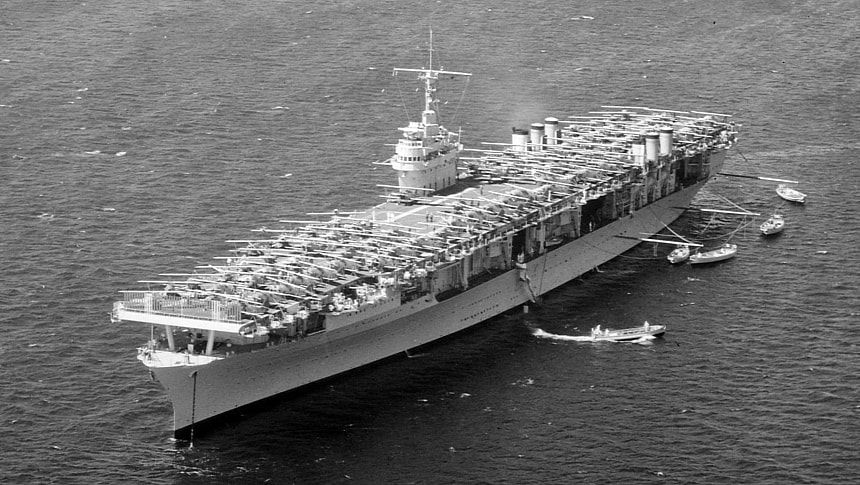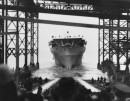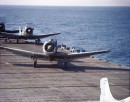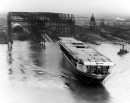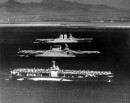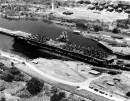At the moment, the US Navy employs 11 aircraft carriers across its fleet. For those not aware, this accounts for just over half of all the world's current operation aircraft carriers currently in service. From a certain point of view, each of these 11 carriers shares the DNA of a particular common ancestor, the USS Ranger. Though not technically the first US carrier, it was indeed the first built from the ground up for the purpose of carrying military airplanes.
In truth, the ship lovingly christened CV-4 couldn't be considered the first true aircraft carrier in US service because its predecessor, the USS Langley, was directly converted from an old Navy collier named the USS Jupiter. Even so, the Ranger, itself named after a long line of US Navy warships dating back nearly to the founding of the nation, had a few party pieces of its own. Laid down in 1931 at the Newport News Shipbuilding yard in Virginia and launched 91 years ago today in 1933, CV-4 helped write the playbook for US carriers going forward.
Though far from the most famous US carrier to see service during the Second World War, more famous ships like the USS Lexington and USS Saratoga were actually converted from battlecruisers into aircraft carriers. This ensured the Ranger's permanent place in history as America's first wholly bespoke, purpose-built carrier. As the carrier helped to formulate the US Navy's strategic air doctrine during the inter-war period, the ship was also a vital proving ground for America's Navy warbirds.
Aircraft from respected and well-remembered aviation manufacturers like Curtiss, Vought, and Grumman received some of their first operational service aboard the Ranger. This includes famous names like the Vought F4U Corsair and the Grumman F4F Wildcat, aircraft that helped turn the tide against Imperial Japan during the Pacific Theater of World War II. But although Wildcats fought in the Pacific Theater of the war in their thousands, CV-4 was not there to serve alongside them.
The ship was determined not to be fast enough to keep up with the break-neck pace of Navy Fast Carrier Task Forces in the Pacific, so the African and European Theater of the war against the German Kriegsmarine was thought to be a better fit for the ship. In service along North African and European waters, CV-4 spent considerable time transporting Army Air Corps P-40 Warhawks to battle against Erwin Rommel's forces while taking part in Allied operations in French North Africa, dubbed Operation Torch.
After completing its services in the war, never once seeing combat against the Japanese, the USS Ranger was stricken from Navy service in 1946 before being broken up the following year. On the anniversary of its operational birth, we owe our thanks to the crew who served onboard.
Though far from the most famous US carrier to see service during the Second World War, more famous ships like the USS Lexington and USS Saratoga were actually converted from battlecruisers into aircraft carriers. This ensured the Ranger's permanent place in history as America's first wholly bespoke, purpose-built carrier. As the carrier helped to formulate the US Navy's strategic air doctrine during the inter-war period, the ship was also a vital proving ground for America's Navy warbirds.
Aircraft from respected and well-remembered aviation manufacturers like Curtiss, Vought, and Grumman received some of their first operational service aboard the Ranger. This includes famous names like the Vought F4U Corsair and the Grumman F4F Wildcat, aircraft that helped turn the tide against Imperial Japan during the Pacific Theater of World War II. But although Wildcats fought in the Pacific Theater of the war in their thousands, CV-4 was not there to serve alongside them.
The ship was determined not to be fast enough to keep up with the break-neck pace of Navy Fast Carrier Task Forces in the Pacific, so the African and European Theater of the war against the German Kriegsmarine was thought to be a better fit for the ship. In service along North African and European waters, CV-4 spent considerable time transporting Army Air Corps P-40 Warhawks to battle against Erwin Rommel's forces while taking part in Allied operations in French North Africa, dubbed Operation Torch.
After completing its services in the war, never once seeing combat against the Japanese, the USS Ranger was stricken from Navy service in 1946 before being broken up the following year. On the anniversary of its operational birth, we owe our thanks to the crew who served onboard.
